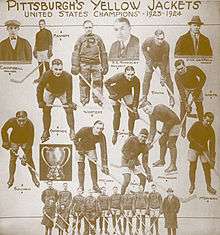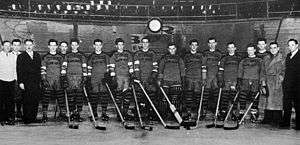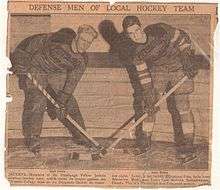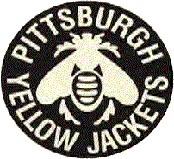Pittsburgh Yellow Jackets
Pittsburgh Yellow Jackets was the name of two separate ice hockey teams based in Pittsburgh, Pennsylvania. The original team played from 1915–1925. They evolved from being an amateur to a semi-pro team and are one of the earliest sports organizations in Pittsburgh, Pennsylvania. The Yellow Jackets played primarily in the United States Amateur Hockey Association (USAHA). After winning the USAHA Championship in 1924 and 1925, the Yellow Jackets were sold to attorney James Callahan and soon became the Pittsburgh Pirates of the National Hockey League. However, after the demise of the Pirates in 1930, a second club (founded by the owner of the original club), debuted in the IHL as a professional entity, before reverting to an amateur club in 1934. The team would finish its run in the EAHL, before finally folding in 1937.
Pittsburgh Yellow Jackets I
| Pittsburgh Yellow Jackets | |
|---|---|
| City | Pittsburgh, Pennsylvania, United States |
| League | United States Amateur Hockey Association |
| Founded | 1915 |
| Operated | 1915–1925 |
| Home arena | Duquesne Gardens |
| Colours |
Black, gold, white |
| Owner(s) |
|
| Head coach |
|
| Captain |
|
| Franchise history | |
| 1915-1921 | Independent |
| 1921-1925 | United States Amateur Hockey Association |
| Championships | |
| Division Championships | (2) 1924,1925 |
| Playoff championships | (2) 1924,1925 |
After a career in local politics, Roy Schooley, a former hockey referee in the Western Pennsylvania Hockey League, founded the Yellow Jackets as an amateur hockey team in 1915.[1] As with all American teams of this era, the Yellow Jackets fell under the jurisdiction of the International Skating Union. For 6 years, the club played in independent competitions. In late October, 1920, the United States Amateur Hockey Association was formed, with Yellow Jackets officials Schooley and W.S. Haddock serving as co-founders and respectively acting as the league's secretary-treasurer and president.[2] The Yellow Jackets played exhibition games against other USAHA clubs in its inaugural season before joining the league full-time in 1921.
"Pittsburgh's Canadians"

According to former sports reporter Paul Sullivan, who covered hockey for much of his life for the Pittsburgh Gazette-Times, the USAHA wasn't a completely amateur league. Sullivan noted that even though the USAHA was called an amateur league, "They didn't come down from Canada because they thought Pittsburgh was a nice place." This leads one to believe that money was paid out to top players in the league.[3] The eastern teams of USAHA soon imported Canadian players, to add to their rosters of local players. In 1923, Schooley had invited Lionel Conacher, a future Hall of Famer, to come to Pittsburgh and officiate games in February 1923, "to see if the crowd would take to him". Schooley then asked Conacher to play with the Pittsburgh Yellow Jackets in a four-game series against his former team, the Toronto Aura Lee hockey team, and against the Hamilton Tigers. Conacher impressed the Pittsburgh fans by scoring 11 of the Yellow Jackets' 23 goals in the four games.[4] Conachar then, under the guidance of Roy Schooley, transformed the Yellow Jackets line-up to an almost Canadian team.[2] Schooley then used his connections in the Pittsburgh media[1] to promote Conachar to the city's hockey fans. After seeing how well the fans took to Conacher, Schooley made him the team’s captain, and asked him to invite a number of his friends to play for the Yellow Jackets. These players included Harold Cotton, Hib Milks, Harold Darragh, Rodger Smith, Duke McCurry, "Tex" White and goalie Roy Worters.[2]
Dick Carroll, who had coached the Toronto Arenas to the Stanley Cup in 1918,[5] was appointed the team's coach once Conacher and his teammates arrived in Pittsburgh for the 1923–24 season by Schooley. However the use of Canadian players drew criticism, with the Boston-based teams leading the charge. In one instance, the Boston Herald questioned why: "Boston hockey … [was] hooked up with Pittsburgh at all… [After all] the best hockey in Boston is played by our own boys … [and Pittsburgh hockey] … is played mainly by a bunch of traveling mercenaries, who practically all are of Canadian birth and training." Some circles also referred to the Yellow Jackets as "Pittsburgh’s Canadians". These imported players joined current Yellow Jackets players Rennison Manners, and Herb Drury, who had just won a silver medal as a member of the U.S. Olympic hockey team.[2][6]
Championship era: 1924 and 1925
In the Yellow Jackets' opening game at the Duquesne Gardens, Conacher scored a hat trick.[4] The Yellow Jackets posted a 15-5-0 record for the 1923-24 season, to earn first place in the league's Western group. Pittsburgh then defeated the critical Boston Athletic Association to win Fellowes Cup 4 games to 1 in playoffs.[7] A Boston newspaper, the Boston Traveller, on January 29, 1924, termed the Yellow Jackets "a wonder team" and another account referred to Conacher as "Canada’s Wonder Athlete". The trio of Rodger Smith, Conachar and Roy Worters was part of Pittsburgh’s "stonewall defense."[4] The Yellow Jackets were so dominant by 1925 that they spun off another Pittsburgh team, named the Fort Pitt Hornets, who played in the Eastern Division.[3] Rennison Manners, who was a player-coach and manager of the Yellow Jackets up until the 1922-23 season, when they were only a .500 club, still played for the team during the 1923-24 season, however the following season he joined crosstown the Fort Pitt Hornets.[2]
In their 1924-25 season, the Yellow Jackets finished their regular season with a 15-3-2 first season half record for first place in the Western Group, followed by a 10-8-2 second half record for second place in the west. The Yellow Jackets would go on to defeat their cross-town rivals, the Fort Pitt Hornets, at the Duquesne Gardens, and win their second Fellowes Cup, four games to none.[7]
The Pittsburgh Pirates and the NHL
The Yellow Jackets stopped playing after the USAHA folded at the end of the 1924–25 season. When Schooley encountered financial problems he sold the team to James Callahan, a lawyer from Pittsburgh's Lawrenceville. Callahan was granted an NHL expansion team and simply transferred the Yellow Jackets into the NHL as his expansion club keeping the entire roster of the Yellow Jackets intact. Schooley wanted to keep the rights to the "Yellow Jackets" name per the sale of the club, so Callahan had to rename the team when it entered the NHL. He choose Pittsburgh Pirates, stealing the name from the baseball club, something the new NFL team would also do eight years later.[8] Callahan kept the Yellow Jackets black and yellow uniforms. He simply modified the "P" logo on the front and had a word mark arched over the "P" that read "Pirates". Because of this, the NHL club wore a black and yellow color combination before the Major League Baseball team did who at the time were red, white, and blue. The Pirates made it to the Stanley Cup semifinals within a year.[9] The Pirates were also barely nudged out of the playoffs. In 1926, the playoff series was just two games long, with total goals deciding the issue. The Pirates, who finished third in the seven-team NHL, lost to the Montreal Maroons, 3-1, in the opener in Pittsburgh and tied, 3-3, in Montreal. The Maroons' 6-4 edge in goals gave them the series and they went on to win the 1926 Stanley Cup. Among the Jackets-turned-Pirates were two Hockey Hall of Famers—Lionel Conacher and goalie Roy Worters. The Pirates would operate from 1925 until 1930.[8]
Season-by-season record
Note: GP = Games played, W = Wins, L = Losses, T = Ties, Pts = Points, GF = Goals for, GA = Goals against, PIM = Penalties in minutes
| Season | GP | W | L | T | Pts | GF | GA | PIM | Finish | Playoffs |
|---|---|---|---|---|---|---|---|---|---|---|
| 1921-22 | 12 | 5 | 7 | 0 | 10 | - | - | - | third in Group 2 | Missed Playoffs[7] |
| 1922-23 | 20 | 10 | 10 | 0 | 20 | 49 | 35 | 0 | fourth in West | Missed Playoffs[7] |
| 1923–24 | 20 | 15 | 5 | 0 | 30 | - | - | - | first in West | Won USAHA Championship over Boston Athletic Association 4-1[7] |
| 1924–25 | 40 | 25 | 11 | 5 | 55 | - | - | - | first in East | Won USAHA Championship over Fort Pitt Hornets 4-0[7] |
Pittsburgh Yellow Jackets II
| Pittsburgh Yellow Jackets | |
|---|---|
 | |
| City | Pittsburgh, Pennsylvania, United States |
| League | International Hockey League, Eastern Amateur Hockey League |
| Founded | 1930 |
| Operated | 1930–1937 |
| Home arena | Duquesne Gardens |
| Colours |
Black, gold, white |
| Owner(s) |
Roy Schooley (1930-32) |
| Head coach |
Charlie Reid (1930-32) |
| Franchise history | |
| 1930-1932 | IHL |
| 1932-1934 | Dormant |
| 1934-1935 | Independent |
| 1935-1937 | EAHL |
| Championships | |
| Playoff championships | (0) |
The Pirates left Pittsburgh and became the short-lived Philadelphia Quakers in 1930, due to issues related to the Great Depression and the failure to find a replacement for the aging Duquesne Gardens. Shortly afterwards, Schooley applied for an expansion franchise in the International Hockey League. He gave the team the name of "Yellow Jackets" which he still had to the rights to. The team competed in the IHL for only two seasons.

In 1932, the Yellow Jackets served as a farm team for the Chicago Black Hawks who often took several of their key players in mid-season.

Before a March 1932 game against the Buffalo Bisons, Pittsburgh's Doc Romnes was recalled to Chicago to aid the team in their NHL title chase.

This left the Yellow Jackets' coach, Charlie Reid to constantly change his forward lines.[10] Also in 1932, The Yellow Jackets were purchased by Pittsburgh theater chain owner, John Harris.[5] However the Yellow Jackets were having financial problems, despite the support Pittsburgh fans gave them, leaving some doubt as to whether the team would operate in 1932-33. On August 22, 1932, it was reported that the defunct Pittsburgh Pirates would be returning to the NHL for the upcoming season. The news put the Yellow Jackets in limbo, since the Pirates still held territorial rights and could deny the team permission to operate. However the trust company that owned the Jackets had the right to deny the NHL team the right to play at Duquesne Gardens. However the optimism was short-lived and on October 1, 1932 the Pirates formally suspended operations.[11] During all this, the Yellow Jackets remained dormant and did not play at all from 1932 through 1934.
In 1934 they were reactivated, but as an independent playing various exhibition games against other clubs.[12] The club would return to league play when, On October 29, 1935, the Montreal Gazette reported that the Yellow Jackets had joined the Eastern United States Amateur Hockey League, with the New York Rovers.[13] During the team's final three seasons of play, Frank Brimsek served as the team's goaltender. Brimesk would go on to win 252 games in goal, which gave him the record for winningest American-born netminder. His record would stand until February 15, 1994, when Tom Barrasso and the NHL's Pittsburgh Penguins, defeated the Winnipeg Jets, 5-3, at the Pittsburgh Civic Arena.[5][14]
The Yellow Jackets had a hand in providing Pittsburgh with another professional hockey team, the Pittsburgh Shamrocks. The idea for the Shamrocks team came about when Yellow Jackets' owner, John Harris, and Charles King, president of the International American Hockey League, met in Pittsburgh to discuss Pittsburgh’s possible entrance into the league in the fall. The meeting resulted in the establishment of the Shamrocks and established that the Gardens' ice time would be split by the new IHL team and the Yellow Jackets, who became the newest members of the Eastern Amateur Hockey League.[5] During his tenure as owner of the Yellow Jackets, John Harris made two notable decisions. First, on March 31, 1936, he hired, Sonja Henie, 24-year-old Norwegian figure skater to perform before a Yellow Jackets’ game, leading to the creation of the Ice Capades.[15] Then, on October 4, 1936, Harris purchased the Detroit Olympics and moved the team to Pittsburgh, where they were renamed the Pittsburgh Hornets. Some players from the Yellow Jackets and Shamrocks players then joined the Hornets. After the 1936/37 season, the club would fold.[12]
Season-by-season record
Note: GP = Games played, W = Wins, L = Losses, T = Ties, Pts = Points, GF = Goals for, GA = Goals against, PIM = Penalties in minutes
| Season | GP | W | L | T | Pts | GF | GA | PIM | Finish | Playoffs |
|---|---|---|---|---|---|---|---|---|---|---|
| 1930-31 | 48 | 21 | 18 | 9 | 51 | 101 | 108 | 0 | fourth in IHL | Missed Playoffs[16] |
| 1931-32 | 48 | 17 | 22 | 9 | 43 | 91 | 118 | 0 | fifth in IHL | Missed Playoffs[16] |
| 1935-36 | 40 | 22 | 16 | 2 | 46 | 108 | 74 | 0 | second in EHL | [17] |
| 1936-37 | 48 | 19 | 24 | 5 | 43 | 119 | 147 | 0 | third in EHL | Missed Playoffs[17] |
Logos and Uniforms

The Yellow Jackets wore yellow wool jerseys with a "P" on the front of their jerseys in 1924. The wool jerseys featured black felt lettering would become the Pirates first set of jerseys. The team used the Pittsburgh's city crest emblems on the uniform sleeves. John McMahon, a sports writer for the Pittsburgh Press once referred to the color of the home jerseys as a "dingy mustard yellow." When the Yellow Jackets evolved into the City's first NHL team, the Pittsburgh Pirates, the color scheme followed. In fact when the City's second NHL team, the Pittsburgh Penguins wanted to change their uniform colors from blue and white to black and gold, a move protested by the Boston Bruins, the Pirates-Yellow Jackets jerseys were showcased as precedence for the move.[18]
Prominent players
The following Yellow Jackets players are enshrined in the Hockey Hall of Fame:
- Frank Brimsek (1966)
- Lionel Conacher (1994)
- Gordie Drillon (1975)
- Roy Worters (1969)
See also
References
- 1 2 "Roy Schooley is Dead After Long Illness". Pittsburgh Post-Gazette. November 14, 1933. pp. C1,C3.
- 1 2 3 4 5 Spence, Ron (September 10, 2008). "USAHA Hockey: Not a Parlour Game". Crashing the Goalie.
- 1 2 Bouchette, Ed (May 2, 1999). "Ice Age". Pittsburgh Post-Gazette.
- 1 2 3 Morrow, Don (Spring 1979). "Lionel Pretoria Conacher". Journal of Sports History. 6 (1): 20–21.
- 1 2 3 4 "1915-1925 Pittsburgh Yellow Jackets". Pittsburgh Hockey.net. Retrieved April 22, 2012.
- ↑ Smith, Brady (January 20, 2011). "Let's Learn From the Past: Herb Drury". Pittsburgh Post-Gazette.
- 1 2 3 4 5 6 "St. Paul Athletic Club". Vintage Minnesota Hockey. 2010. Retrieved April 23, 2012.
- 1 2 Christman, Paul. "1925-30 Pittsburgh Pirates Hockey (NHL)". Pittsburgh Hockey.net. Retrieved April 23, 2012.
- ↑ Trietley, Greg (November 1, 2011). "Oakland once the hockey center of Pittsburgh". Pitt News.
- ↑ Huhn, Joe (March 19, 1932). "Yellow Jackets Encounter Buffalo Six Here Tonight". Pittsburgh Press. p. 9.
- ↑ Christman, Paul. "1931-1936 Former Pirates Franchise Looking for Rebirth". Pittsburgh Hockey.net. Retrieved April 24, 2012.
- 1 2 "1935-36 Pittsburgh Shamrocks (IHL)". Pittsburgh Hockey.net. Retrieved April 24, 2012.
- ↑ "U.S. Hockey League to Operate With 5 Clubs". Montreal Gazette. October 29, 1935. p. 14.
- ↑ "This day in Pittsburgh Penguins history...". Retrieved April 24, 2012.
- ↑ Grove, Bob. "Pittsburgh hockey thriving for more than a century". Pittsburgh Hockey.net. Retrieved April 24, 2012.
- 1 2 "Standings for the Pittsburgh Yellow Jackets of the IHL". Hockey Database. Retrieved April 23, 2012.
- 1 2 "Standings for the Pittsburgh Yellow Jackets of the EHL". Hockey Database. Retrieved April 23, 2012.
- ↑ "Pittsburgh Yellow Jackets Jerseys". Pittsburgh Hockey.netaccessdate=April 24, 2012.